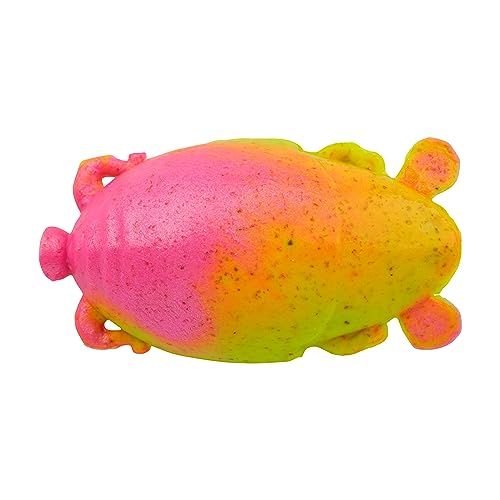For surf fishing, the reel size you need generally depends on the size of the fish you’re targeting and the distance you’ll be casting. Typically, a reel size between 4000 and 8000 is suitable for surf fishing.
Surf fishing is a popular angling technique that involves casting from the shoreline into the open ocean. It’s an exciting way to catch a variety of fish species, including striped bass, red drum, and bluefish. To embark on a successful surf fishing adventure, you need to equip yourself with the right gear, and choosing the right reel size is crucial.
In this guide, we’ll explore the factors to consider when selecting a reel size for surf fishing, so you can make an informed decision and enhance your chances of reeling in that trophy fish. Read on to learn more!

Credit: fishtalkmag.com
Understanding Surf Fishing Reels
Differentiating Surf Fishing Reels From Other Types
Surf fishing requires specific gear that is suited to withstand the harsh conditions of the ocean waves. Unlike other types of fishing reels, surf fishing reels are designed to provide increased line capacity, casting distance, and durability. Here are a few key points to help you understand how surf fishing reels differ from other types:
- Surf fishing reels typically have larger spools to accommodate thicker fishing lines, allowing you to target bigger fish species found in the ocean.
- These reels often feature a sturdy construction, with corrosion-resistant materials such as graphite or aluminum, to withstand saltwater exposure.
- Surf fishing reels are equipped with powerful drag systems to handle the strong pulls and fights that occur when battling fish in the surf.
- These reels are designed for long-distance casting, allowing you to reach fish that are farther out in the water.
- They usually have a higher gear ratio, allowing for quicker line retrieval when fighting against the strong currents encountered in the surf.
Key Features To Consider When Choosing A Surf Fishing Reel
When selecting a surf fishing reel, there are certain features you should prioritize to ensure optimal performance in surf fishing conditions. Here are a few key points to consider:
- Line capacity: Look for a reel with a large line capacity, as surf fishing requires heavier lines to handle the larger fish species commonly found in the surf.
- Gear ratio: Consider a reel with a high gear ratio for faster line retrieval to keep up with the fast-moving ocean currents.
- Drag system: Opt for a reel with a strong and smooth drag system that can handle the powerful pulls and runs of saltwater gamefish.
- Durability: Since surf fishing exposes your gear to corrosive saltwater, choose a reel made with corrosion-resistant materials, such as graphite or aluminum.
- Casting distance: Look for a reel with features like long spool lips and a large line capacity to achieve greater casting distances, reaching fish that are further out in the surf.
How Reel Size Affects Surf Fishing Performance
The size of your surf fishing reel plays a crucial role in your overall fishing performance. Here’s how reel size affects various aspects of surf fishing:
- Casting distance: Larger surf fishing reels typically have longer spools, allowing you to load more line and achieve greater casting distances. This is especially advantageous when you’re targeting fish that are further out in the surf.
- Line capacity: Surf fishing reels with larger spools have greater line capacity, accommodating thicker lines needed to handle the strength of saltwater gamefish. With higher line capacity, you can tackle larger species without worrying about running out of line.
- Retrieval power: Larger reels often have higher gear ratios, resulting in faster line retrieval. This is beneficial when you need to quickly bring in your line and reposition your bait or lure while surf fishing.
- Durability: Generally, larger surf fishing reels offer a more robust and durable construction. This helps them withstand the harsh saltwater environment and handle the demanding nature of surf fishing.
Remember, the size of your surf fishing reel should be chosen based on the target species, surf conditions, and your personal preferences. Selecting the right reel size can greatly enhance your surf fishing experience and increase your chances of success on the water.
Selecting The Right Reel Size For Surf Fishing
When it comes to surf fishing, choosing the right reel size is crucial for a successful and enjoyable fishing experience. The size of your reel will not only affect your casting distance but also your ability to handle different fish species and surf conditions.
To help you make an informed decision, here are some factors to consider when determining the reel size for surf fishing:
Factors To Consider When Determining Reel Size For Surf Fishing
- Fish species: Different fish species require different reel sizes. Smaller fish like flounder and pompano can be easily landed with a smaller reel, while larger predators like striped bass and redfish will require a larger, more powerful reel to handle their strength.
- Line capacity: It’s essential to choose a reel that can hold enough line to accommodate the target species and the surf conditions you’ll be fishing in. Surf fishing often requires longer casts, so having enough line capacity is crucial.
- Drag power: A reel with a strong and smooth drag system is necessary for surf fishing. This will allow you to easily control the fish and prevent line breakage when fighting against the surf’s strong currents.
- Gear ratio: The gear ratio of a reel determines how quickly you can retrieve your line. A higher gear ratio means faster line retrieval, which can be beneficial when dealing with fast-swimming species or when you need to reel in your line quickly to make another cast.
Matching Reel Size With Target Fish Species
- Smaller fish species: For smaller fish species like flounder, pompano, and whiting, a reel with a size of 2500 or 3000 is generally sufficient. These reels offer a good balance between line capacity, casting distance, and ease of use.
- Medium-sized fish species: If you’re targeting medium-sized fish like redfish, speckled trout, and bluefish, consider using a reel in the 4000 to 5000 size range. These reels provide more line capacity and drag power, allowing you to tackle larger fish without straining your equipment.
- Larger fish species: When pursuing larger fish species such as striped bass, tarpon, and shark, a reel size of 6000 or higher is recommended. These larger reels offer the strength and line capacity necessary to handle the power and size of these big predators.
Adjusting Reel Size Based On Surf Fishing Conditions
- Heavy surf conditions: If you’re fishing in heavy surf conditions with strong currents and large waves, opting for a slightly larger reel size can provide additional line capacity and drag power. This will help you handle the challenging conditions and prevent your line from breaking easily.
- Light surf conditions: In contrast, if you’re fishing in calm waters with minimal surf, you might consider downsizing your reel to increase casting distance. Smaller reels are typically lighter and more manageable, allowing for longer and more accurate casts.
By considering these factors and matching your reel size to your target fish species and surf fishing conditions, you’ll be well-equipped to make the most of your surf fishing adventures. Remember, choosing the right reel size is just one piece of the puzzle – proper technique, good bait selection, and knowledge of the fish behavior in your area are also vital for a successful day on the beach.
So, pack your gear, pick the right reel, and get ready to reel in some memorable catches on your next surf fishing trip.
Tips And Techniques For Surf Fishing With The Right Reel Size
Surf fishing is a popular activity that requires the right equipment, and choosing the correct reel size is crucial for a successful fishing experience. In this section, we will explore some tips and techniques for surf fishing with the right reel size.
Whether you are a beginner or an experienced angler, these insights will help you maximize your reel’s performance, ensure its longevity and functionality, and even dive into advanced techniques. Let’s dive in!
Casting Techniques For Maximizing Reel Performance:
- Proper casting technique is essential to maximize the performance of your surf fishing reel. Here are some tips to keep in mind:
- Use proper body mechanics and weight transfer to generate power and distance in your cast.
- Master the pendulum cast, which involves rotating your body to generate momentum before releasing the line.
- Practice the overhead cast, which allows for longer and more accurate casts.
- Keep your casting arm relaxed and smoothly execute the cast to avoid backlash and improve accuracy.
- Experiment with different casting styles, such as sidearm or spey casting, to adapt to varying surf conditions.
Proper Reel Maintenance For Longevity And Optimal Functionality:
- Taking good care of your surf fishing reel is crucial. Follow these maintenance tips to extend its lifespan and ensure optimal functionality:
- Rinse the reel with fresh water after each fishing session to remove sand, salt, and other debris that could cause damage.
- Regularly lubricate the reel’s moving parts using a reel oil or grease to prevent friction and ensure smooth operation.
- Check the drag system and adjust it according to the target species and conditions you’ll be fishing in.
- Inspect the line regularly for wear, knots, or damage, and replace it when necessary.
- Store the reel in a cool and dry place to avoid exposure to extreme temperatures or excessive humidity.
Exploring Advanced Techniques With The Right Reel Size:
- Once you have mastered the basics, you can dive into more advanced surf fishing techniques with the right reel size. Here are some techniques to consider:
- Fishing the trough: Target the area between breaking waves, where predatory fish often lurk to feed on disoriented baitfish.
- Long-distance casting: By using a higher gear ratio reel and practicing advanced casting techniques, you can reach spots that are otherwise inaccessible.
- Live bait rigging: Rigging live bait, such as sand fleas or mullet, can entice larger predatory fish to bite.
- Surf plugging: Use lures like topwater poppers or diving plugs to imitate injured baitfish and attract aggressive fish.
- Bottom fishing: Target bottom-dwelling species by anchoring your bait to the seabed using a sinker and strong leader.
With the right reel size and these tips and techniques, you’ll be well-equipped to tackle surf fishing with confidence. Remember, practice makes perfect, so get out there, experiment, and adapt your approach to varying conditions. Happy fishing!
Conclusion
Selecting the right reel size for surf fishing is crucial to ensure a successful and enjoyable experience. By considering factors such as the target species, fishing location, and line capacity, you can determine the appropriate reel size that will maximize your chances of landing the catch.
Understanding the gear ratio and drag system of the reel will also help in making an informed decision. Remember, a larger reel size with a higher line capacity is suitable for surf fishing as it allows for longer casts and can handle the power of saltwater species.
On the other hand, a smaller reel size with a lighter line capacity is better suited for light tackle fishing or targeting smaller fish. Don’t forget to balance the reel size with the fishing rod you choose to achieve optimal performance.
Ultimately, research and experimentation will help you find the ideal reel size that matches your fishing style and preferences. So, get out there, cast your line, and enjoy the thrill of surf fishing!






